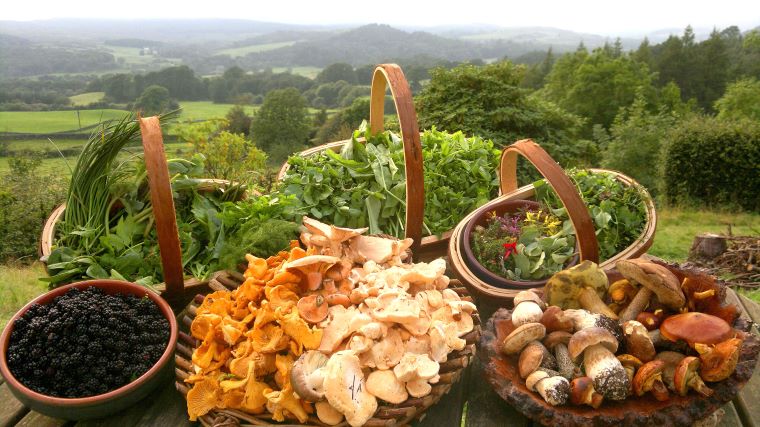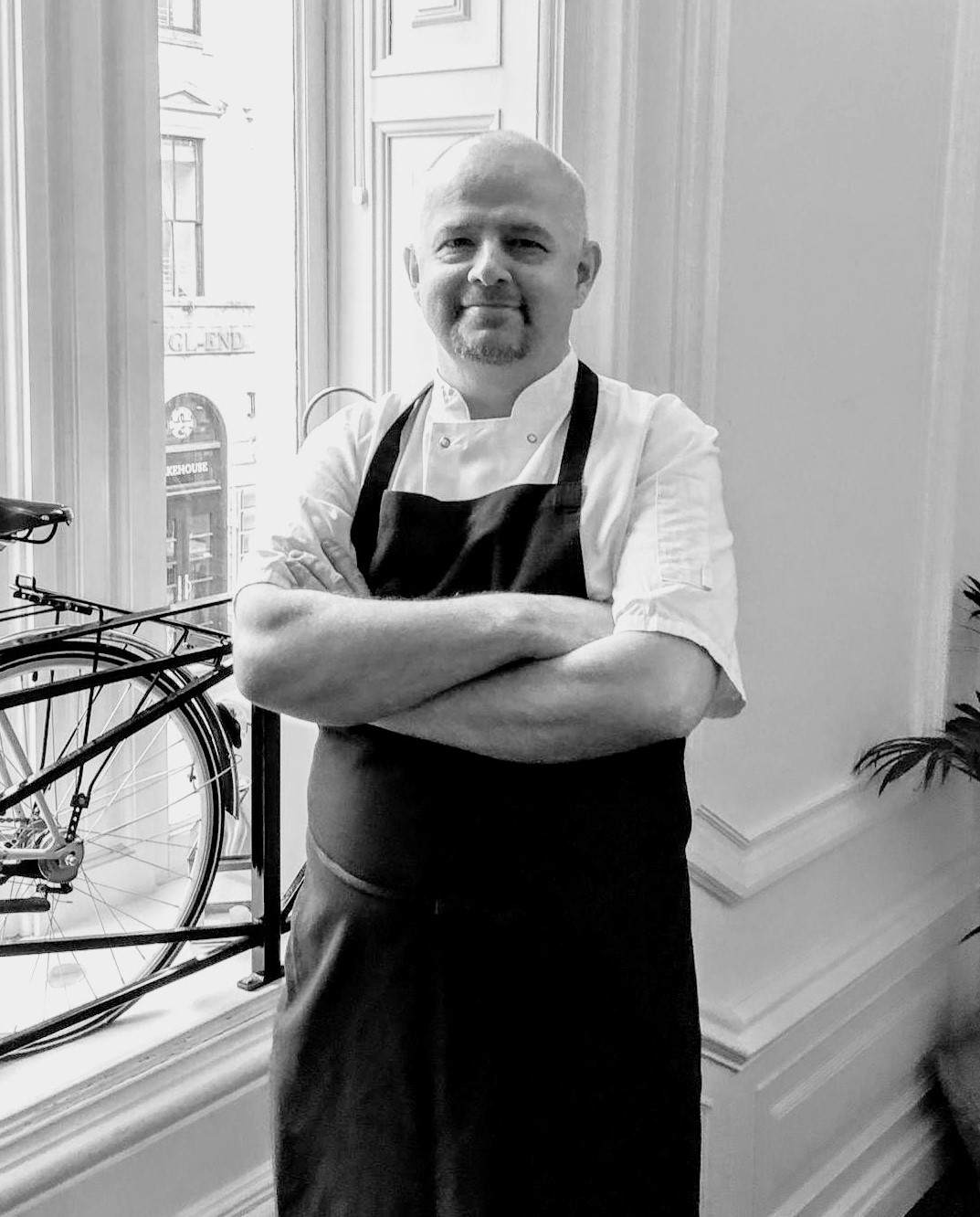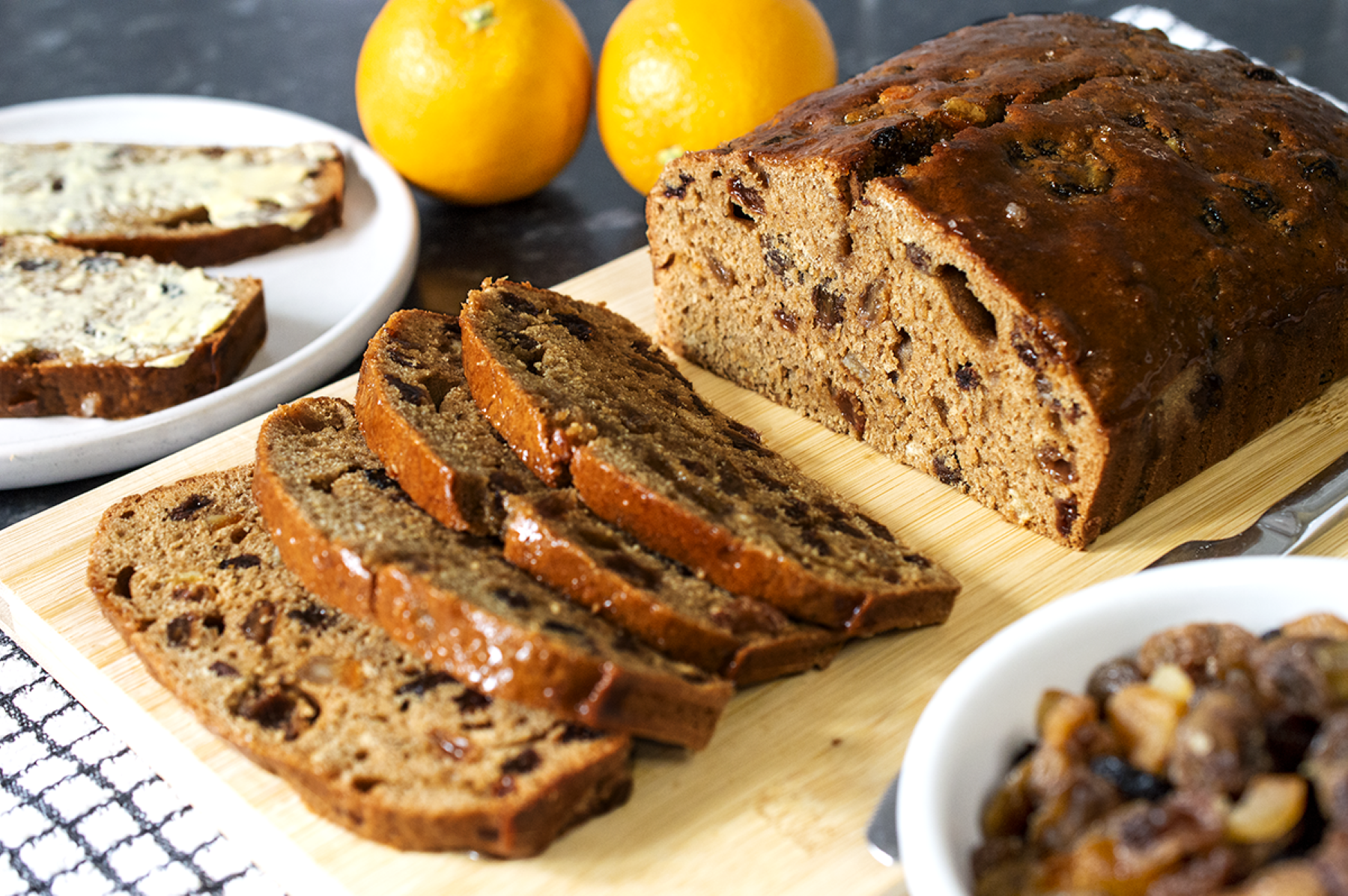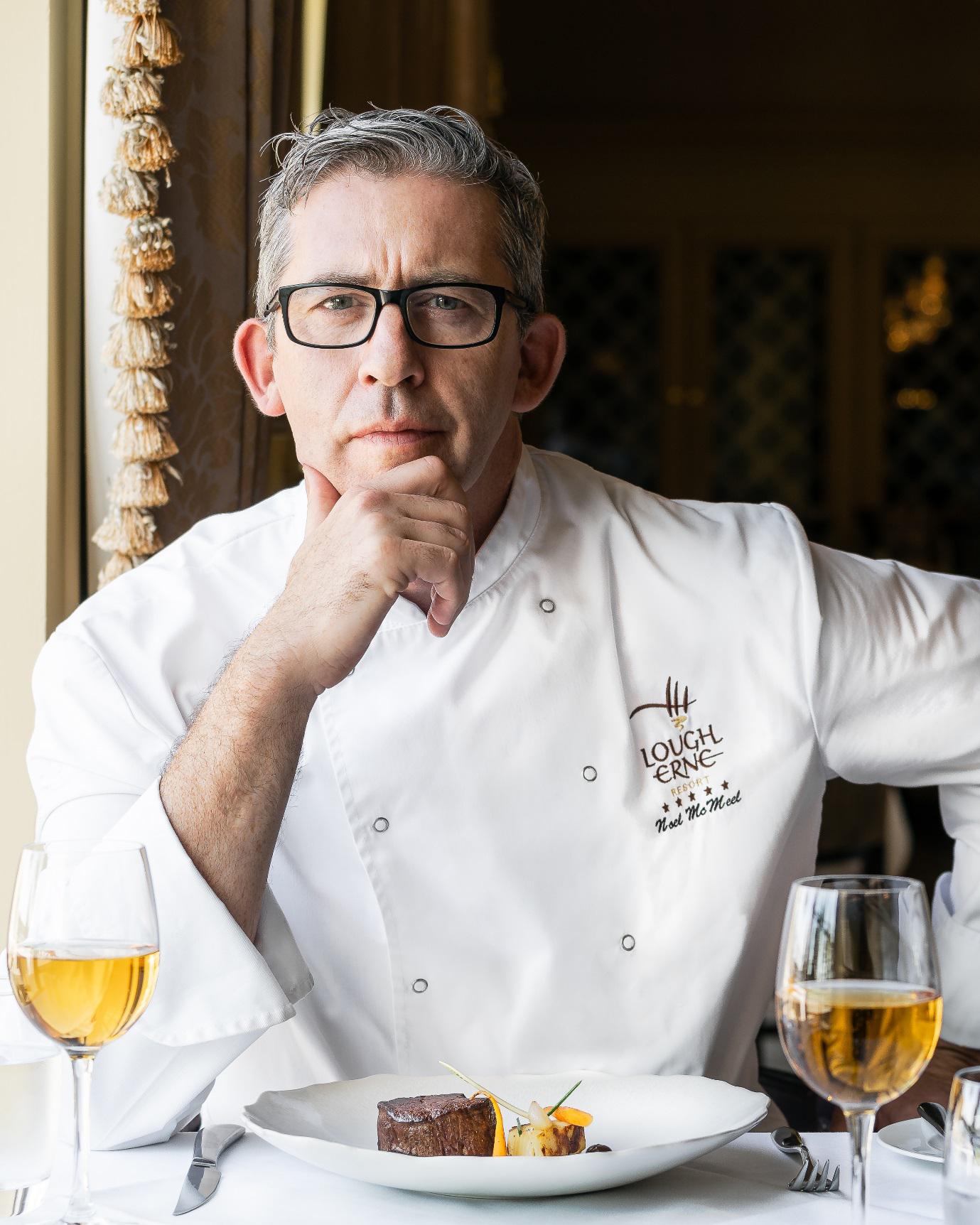
Gary Maclean recounts when he first realized that cooking could be a career, and not just something mom does to put dinner on the table.
“I grew up in the northwest of Glasgow, kind of working-class background,” shares Maclean, who faithful readers of Celtic Life International will recognize as The Celtic Chef, our renowned cooking columnist.
“I got into cooking because I was hopeless at school. In fact, I was hopeless at absolutely everything, apart from home economics. But I had a really good home economics teacher and went from being the worst in every class in the school to being the best in home economics.
“I found a real passion for food at a really early age,” he continues. “I was about 12 when I realized it. It was something that I enjoyed, and put some effort into – and I did all that before realizing that I could actually cook for a living. Back then, there were chefs on TV – you weren’t eating out in restaurants or anything like that. That whole world was completely different to what we see now.”
Scotland is renowned for a number of traditional regional dishes: Cullen skink, langoustine, black pudding, clapshot, and – perhaps most famous of all – haggis.
Maclean muses that there wasn’t any specific dish that drew him in to a love of cooking – if anything, it was the ingredients.
“It probably wasn’t even the joy of eating – it was probably the joy of making that pulled my interest if truth be told. Being able to serve it to other people was better than even having it myself. I quite liked the fact that you could mix flour and butter and oatmeal, and it comes out as something really delicious. I was amazed that you could bring several ingredients together and make something completely different.”
That love for integrating ingredients paved Maclean’s path; by 22, he had already landed a job as head chef at a gastropub, with many other gigs in restaurants across Scotland to follow. You may have even seen him on TV, where he would take the top spot in the U.K.’s 2016 season of MasterChef: The Professionals.
“It was dubbed by one of the broadsheets the year I was in that it was the cruellest reality TV show on the planet because there is no other show where people do what they do for a living in front of millions of people every night.”

Maclean’s most recent project is a book he is launching in North America, containing recipes for all those traditional Scottish dishes.
“It is called the Scottish Kitchen,” he shares. “It is a book about the history of Scottish food – those fundamental, almost cliché staple dishes that we have in Scotland, along with meals that I remember from my childhood.”
Despite cultivating most of his culinary career in Scotland, however, it might surprise you to learn that he doesn’t often make many of those staple Scottish dishes himself.
“There are things in there that I had to teach myself how to make, but felt it was important that were in the book. You know, things like morning rolls, which we don’t make because we have exceptional bakeries that make them. Scotch pies, tattie scones, all that sort of stuff.”
“I had to come up with my own recipe for haggis because chefs don’t make haggis. Butchers make haggis. No one writes a recipe for haggis.”
Maclean explains that some of these famously Scottish dishes – like haggis – were once made in the home out of necessity. However, now that the world has industrialized enough that folks can nip out to the shops to get many of these items, they haven’t fallen into the purview of high-end chefs like himself. Usually, anyway.
“Haggis is fundamentally a sausage, you know. Some high-end restaurants will make their own, while other top spots will use different animals. There are a couple of very famous restaurants in Glasgow – Stravaigin and Ubiquitous Chip – that were famed for making venison haggis. But, generally speaking, people don’t make haggis at home. You go to the supermarket and buy it.”
Elsewhere in Glasgow, Jean-Paul Giraud is heating up the kitchens for Virgin Hotels as their executive chef in the city. Giraud grew up under the tutelage of two guiding gourmands: his classically trained French chef father, and his Welsh granny.
“My grandmother would make a fruit loaf called Bara Brith,” Giraud explains over a Zoom chat. “It is like a traditional fruit cake, but it is much moister than a lot of fruit cakes. I remember coming home from school, getting some Bara Brith with some butter on it and a really milky cup of tea.”
Giraud recalls that, as a young man growing up in the area of Porthmadog, Wales, the local grocery aisles looked a lot different than they do today – and, as a result, so too did the food that wound up on his plate.
“I am 51 now, but I can still remember going to the supermarket when I was young, and you wouldn’t see half of the stuff that you see now. Not even a quarter of the stuff, really. So, you worked with a lot of root vegetables and potatoes, as well as local meats, eggs, and dairy. It was probably a little unhealthy for you, to be fair. But my God, it tasted good. It was local because it was all that was available.”

Porthmadog being a coastal town, there was also a fair bit of seafood available to Giraud. For most of the country, however, farm-based meals were the norm.
“I think all traditional Celtic food, unless you are growing up by the coastline, is what the French would call Paysanne-style foods – like farmer-style food: heavier stews and breads, food from the land of the area that you are in. Even going back to my French heritage, and even in places like Bretagne in France, it was very much the food of the land.”
As he trained to become a chef like his father (and two of his brothers), Giraud’s tastes and capabilities in the kitchen began to change. Produce became more global, more perennial, and people wanted to enjoy their favourite foods anywhere, any time of the year. The result is that fewer everyday meals featured classic Celtic dishes in the Celtic world.
According to a study by YouGov.co.uk from 2019 that polled Scottish residents about Scottish fare that they have tried (and whether or not they liked it), around 90 per cent had tried items like haggis, Lorne sausages, Scotch broth, and Scotch pie, but only 60-70 per cent actually enjoyed them. Meanwhile, only 54 per cent of respondents had tried black bun, and 23 per cent had imbibed rumbedethumps, and fewer still – as low as 11 per cent – cared for them.
Also impacting dinner selection is the fact that there is simply more to choose from, both in terms of produce from around the world, and in styles of cuisine from different cultures.
“In Glasgow, there are a lot of Italian influences in the food, as a lot of Italians moved there in the 1940s and 1950s,” Giraud explains, adding that there has been a lot of cultural cross contamination over the decades. “People might think that something is Scottish, but it started somewhere else.”
Going back to Maclean, he says his new book was written for overseas audiences, in part because they are more excited about Scottish cuisine than the Scots are.
“My book is slightly different as it is targeted to a North American audience, who totally embraced the ancient cultures and traditions of Scotland. I travel in the States a lot and I work with all the Scottish societies. The idea was to a degree, almost, save our heritage, you know? Get it on record. I have been quoted saying it: if Scotland had the passion for Scotland the American Scots have got for Scotland, we would be a superpower.”
“Here at home, we didn’t look at our own food at all. We didn’t learn about it. We didn’t embrace it. We didn’t celebrate it.”
Maclean adds that many of us, and many chefs cooking around the world, have gotten used to being able to source anything from anywhere at anytime.
“Through my career I have seen that change, and we all embrace – all chefs embrace – having strawberry tarts on Christmas menus and stuff like that. We all thought it was fine. You can walk into a supermarket on the 1st of January and buy strawberries pretty much anywhere in the northern hemisphere. Just because we can, it doesn’t mean we should.”
However, between the rising costs of produce and shipping, the desire to be greener when it comes to our global food market, and provenance becoming a more desirable quality amongst diners, more Celtic chefs are realizing that the best ingredients on offer are those that are in their own back yard, with some reinventing what makes a dish “Celtic” in the process.

“What is happening now in Scotland is that chefs are totally embracing ingredients from our own land,” says Maclean. “There is the green agenda as well, as people are looking to name the farmer, to name the fisherman, and to only buy food within a certain radius of the restaurant. People are going back to where we were maybe 150 years ago, when you could only buy local food.”
“We are getting back to our seasonal food, local food. That is the big Revolution – getting back to our cultural food through the ingredients.”
Giraud’s employers at Virgin Hotels brought him on specifically to help tout the regional eats – a mandate that he is more than happy to fulfill.
“When I first joined the company, I took that to heart and started reaching out to all the local suppliers and asking, what can we do that is Scottish?” notes Giraud. “So, before I had even written the menu, I was discovering all the great Scottish product that we could get, and then incorporating much of it into the menu.
“I am going to use Scottish because it’s great,” he adds enthusiastically. “I am probably a bit of a walking advert for Scotland now, even though I am a very proud Welsh and French person. But I love the product they do in this country. I love being surrounded by great langoustine and lobsters and seafood and oysters and beef and fantastic Aberdeen lamb.”
Noel McMeel, head chef at Lough Erne Resort in Northern Ireland, is of a similar mind.
“I have dedicated my entire career to one very simple goal: finding, preparing and serving fresh food in season,” McMeel tells Celtic Life International. “When possible, let ingredients dictate a menu, rather than recipes. Go to farmers markets and specialty food shops and choose produce and ingredients that speak to you, that look prime, seductive, and make you go ‘mmmm!’ Take your bounty back to the kitchen, and then reach for the recipe books. Any of the chefs from Ireland that respect the produce that we have in this country are able to showcase it on our menus.
“A high percentage of the food bought for Lough Erne Resort is from local producers,” he continues. “Reducing food miles is not merely about supporting the environment and the local economy, but also about sourcing the freshest quality ingredients possible.”
“My life and work philosophy is maintained in time in a perennial way,” writes Lucía Freitas, a Galician chef with several restaurants both in Spain and New York City. “We, the chefs, must put in value our products and our most ancestral cuisine, reinventing those traditional recipes that, due to the passing of time and our current lifestyle, are being forgotten. We need to rediscover and contribute with innovation to tradition so that it remains alive, seeking excellence every day.”
Traditional Celtic foods aren’t at risk of going extinct, per se – even if they are eaten less often and by fewer people than they used to be in their countries of origin. Part of the reason for that is that there are just so many more options available.
“No, I don’t think it is in danger,” says Giraud. “The traditional Scottish things, if you want, are available and are still popular. Do people still want to have haggis, neeps, and potatoes? Yeah, they do. They don’t eat it all the time because the options have doubled and tripled.”
And going back to favouring local, seasonal ingredients doesn’t have to mean going back to the same old recipes, either. It doesn’t even mean doing away with cultural flavours from other parts of the world. It just means chefs like Giraud get to be creative in the kitchen.

“What we are trying to do here is promote Scotland in every way, but also giving people options and choices of flavours that they like but trying to use as much Scottish product as possible with it,” he explains, while listing ways that he has created Italian-style dishes with Scottish ingredients. “I have a risotto – there is your tip to the Italian heritage – but the ingredient in the risotto is a Cullen skink. It’s got smoked haddock and leeks and potatoes. So, we have basically taken an Italian dish and put a bit of Scottish into it.”
In his upcoming book, Maclean dedicates a whole chapter to a community garden in Glasgow, where he’s been rediscovering the magic that the combination of the perfect ingredients brings to any meal.
“I know that particular garden actually supplies a lot of restaurants,” he says. “I asked, ‘just make me up a box of what’s available right now.’ I took that box home, and I wrote a chapter in the book from it. The ingredients led that whole story. They spoke for themselves.”




















Leave a Comment